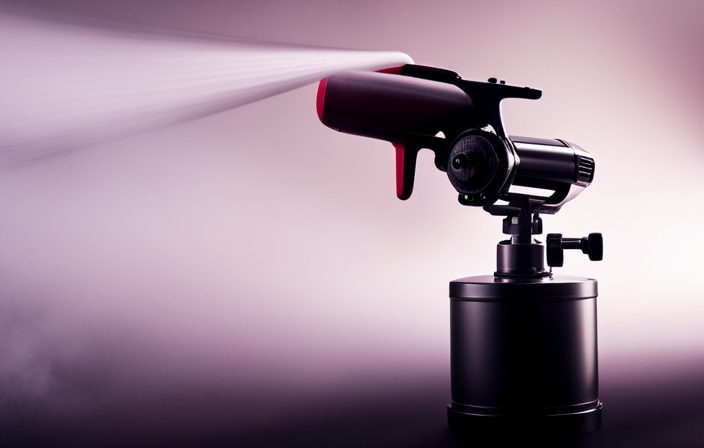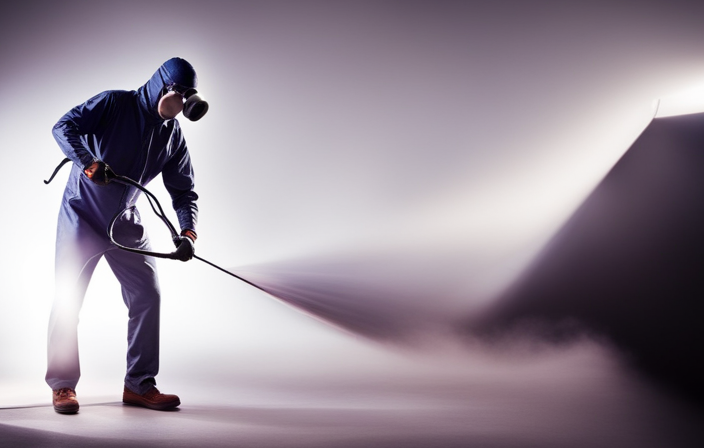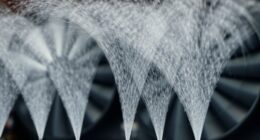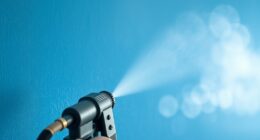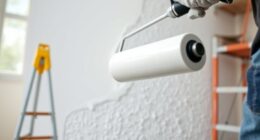Did you know that airless paint sprayers are capable of spraying paint at pressures of up to 3,000 PSI? This high pressure allows for a consistently smooth and even paint finish on different surfaces!
In this article, I will guide you through the inner workings of airless paint sprayers and explain how they operate.
First and foremost, the pumping system is the heart of an airless paint sprayer. It pressurizes the paint, allowing it to be expelled through the spray gun and nozzle. Speaking of which, the spray gun and nozzle play a crucial role in controlling the pressure and spray pattern of the paint.
Adjusting the pressure and spray pattern is essential for achieving the desired finish. Additionally, selecting the right tip size for your project is crucial to ensure optimal coverage.
Using an airless paint sprayer comes with numerous advantages, such as faster painting times and a more professional-looking finish. However, it’s important to know the proper techniques for efficient and clean painting.
Lastly, I will discuss the maintenance and cleaning required for your airless paint sprayer, as well as common troubleshooting and solutions. So, let’s dive into the fascinating world of airless paint sprayers and discover how they work!
Key Takeaways
- Airless paint sprayers use high-pressure pumps instead of compressed air to deliver paint onto a surface with enough force to atomize it.
- The pumping system, consisting of a motor, piston, and high-pressure hose, pressurizes the paint for expulsion through the spray gun and nozzle.
- The spray gun and nozzle control the pressure and spray pattern of the paint, allowing for adjustments to achieve the desired finish.
- Proper maintenance of the spray gun and selection of the right tip size are crucial for achieving professional-quality results and efficient painting.
Understanding the Basics of Airless Paint Sprayers
So, let’s break it down: You’re probably wondering how an airless paint sprayer actually works, right? Well, it all comes down to the paint sprayer technology.
Unlike traditional paint sprayers that rely on compressed air to atomize the paint, airless paint sprayers use a high-pressure pump to force the paint through a small opening, creating a fine mist. This technology offers several benefits of airless spraying.
Firstly, it allows for a more even and consistent application of paint, resulting in a smooth and professional finish. Secondly, it reduces overspray, saving you time and money on paint and cleanup. Lastly, it enables you to apply paint at a much faster rate, significantly speeding up your painting projects.
Now, let’s move on to the pumping system: how paint is pressurized.
The Pumping System: How Paint is Pressurized
To pressurize the paint, you simply squeeze the trigger and let the pumping system do its job. The pumping system is one of the key components of an airless paint sprayer. It consists of a motor, a piston, and a high-pressure hose. When you pull the trigger, the motor starts running and drives the piston forward, creating pressure in the system.
This pressure forces the paint out of the hose and into the spray gun. The high-pressure hose ensures that the paint is delivered to the spray gun with enough force to atomize it into fine particles. This is one of the main benefits of using a paint sprayer – it allows for a more even and professional finish compared to traditional paintbrushes or rollers.
Moving on to the next section about the role of the spray gun and nozzle…
The Role of the Spray Gun and Nozzle
Now let’s talk about how you can get the perfect paint finish with the help of the spray gun and nozzle. The spray gun is a crucial component of an airless paint sprayer, responsible for delivering paint onto the surface. It is important to properly maintain the spray gun to ensure optimal performance. This includes cleaning it regularly to prevent clogs and blockages.
Additionally, the nozzle plays a vital role in determining the spray pattern and the amount of paint being released. Nozzle selection is crucial as it determines the width and shape of the spray pattern. Different nozzles are available for different types of projects, so it’s important to choose the right one for the desired finish.
By properly maintaining the spray gun and selecting the correct nozzle, you can achieve a flawless paint finish.
Now, let’s move on to adjusting pressure and spray pattern.
Adjusting Pressure and Spray Pattern
When adjusting the pressure and spray pattern, you can create a smooth and even coat of paint, transforming an old, worn-out piece of furniture into a stunning centerpiece that adds a touch of elegance to any room.
Adjusting the pressure on an airless paint sprayer allows you to control the amount of paint being released. Higher pressure results in a thicker coat, while lower pressure gives a thinner coat. By experimenting with different pressures, you can find the perfect balance for your project.
Similarly, adjusting the spray pattern allows you to choose between a wide or narrow spray fan. A wide fan covers larger surfaces quickly, while a narrow fan provides more precision. These adjustments are crucial for achieving professional-looking results.
Speaking of achieving optimal results, the next step is choosing the right tip size for your project.
Choosing the Right Tip Size for Your Project
Selecting the appropriate tip size for your project is essential in achieving professional-quality results and ensuring a smooth and even application of paint. The tip size determines the width of the spray pattern and the amount of paint being released.
For smaller projects or detailed work, a smaller tip size, such as 0.015 inches, is recommended. This provides greater control and precision. On the other hand, larger projects require a larger tip size, such as 0.021 inches or 0.031 inches, to cover a wider area quickly.
It’s important to consider the type of paint being used as well. Thicker paints, like latex, may require a larger tip size to prevent clogging. Experimenting with different tip sizes and painting techniques can help troubleshoot any issues and achieve the desired results.
Transitioning into the importance of proper paint preparation, it is crucial to ensure a clean and smooth surface before painting.
The Importance of Proper Paint Preparation
Before you begin your painting project, it’s crucial to properly prepare the surface to ensure a flawless and long-lasting finish. Surface preparation involves a series of steps that are essential for achieving professional results.
Firstly, clean the surface thoroughly to remove any dirt, grease, or debris. This can be done using a pressure washer or a mild detergent solution.
Next, repair any cracks or imperfections by filling them with a suitable filler and sanding them smooth.
Once the surface is clean and repaired, apply a primer to promote paint adhesion and prevent peeling or blistering.
Finally, ensure that the surface is dry and free from dust before applying the paint.
By following these painting techniques and properly preparing the surface, you can achieve a smooth and durable finish.
In the next section, we’ll discuss the advantages of using an airless paint sprayer.
Advantages of Using an Airless Paint Sprayer
One way to achieve professional results in your painting project is by utilizing the advantages of an airless paint sprayer. An airless paint sprayer offers numerous benefits that make it a popular choice among professional painters and DIY enthusiasts alike.
Firstly, an airless paint sprayer provides a faster and more efficient painting process compared to traditional methods. The high-pressure system allows for a uniform and consistent spray pattern, resulting in a smooth and even finish.
Additionally, an airless paint sprayer can handle a wide range of materials, including thick and textured coatings, making it versatile for various painting projects.
Furthermore, the lack of air in the sprayer eliminates the risk of air bubbles or overspray, ensuring a clean and precise application. These advantages make an airless paint sprayer an essential tool for achieving professional-quality results in your painting endeavors.
Moving on to tips for efficient and clean painting…
Tips for Efficient and Clean Painting
To achieve a smooth and seamless finish on your painting project, it’s important to keep your strokes as smooth as butter. Efficient painting techniques and cleaning tips can help you achieve professional-looking results while using an airless paint sprayer. Here are some tips for efficient and clean painting:
- Start by preparing the surface properly, ensuring it is clean and free from any dirt or debris.
- Use a high-quality paint and strain it before loading it into the sprayer to remove any impurities.
- Maintain a consistent distance between the sprayer and the surface to ensure an even application.
- Keep your hand steady and move the sprayer in a smooth, controlled motion to avoid uneven coverage.
- Overlap each stroke slightly to prevent any gaps or streaks in the paint.
By following these efficient painting techniques and cleaning tips, you can achieve professional results with your airless paint sprayer. To keep your sprayer in optimal condition, it is important to regularly maintain and clean it. [Transition sentence into the subsequent section about maintenance and cleaning of your airless paint sprayer.]
Maintenance and Cleaning of Your Airless Paint Sprayer
Now that we’ve covered some tips for efficient and clean painting, it’s important to discuss the maintenance and cleaning of your airless paint sprayer. Proper maintenance is essential to keep your sprayer in optimal condition and ensure its longevity.
Regular cleaning techniques, such as flushing the system with water or solvent after each use, will prevent clogging and maintain the sprayer’s performance. Additionally, it’s crucial to follow a maintenance schedule. This includes lubricating moving parts, inspecting hoses and filters for any damage, and replacing worn-out parts as needed.
By adhering to these maintenance practices, you can avoid costly repairs and downtime.
Moving forward, let’s delve into common troubleshooting and solutions to address any issues that may arise with your airless paint sprayer.
Common Troubleshooting and Solutions
If you’re experiencing any issues with your airless paint sprayer, troubleshooting common problems and finding suitable solutions is crucial for optimal performance and longevity. Here are some troubleshooting tips to help you address common issues:
-
Clogged spray tip:
-
Remove the spray tip and clean it thoroughly with a solvent or a cleaning solution.
-
Use a small brush or needle to remove any debris or paint buildup.
-
Replace the spray tip if it’s damaged or worn out.
-
Inconsistent spray pattern:
-
Check the fluid pressure and adjust it according to the manufacturer’s recommendations.
-
Inspect the spray gun for any clogs or blockages and clean them if necessary.
-
Ensure that the paint is properly mixed and strained before using it.
-
Motor not starting:
-
Check the power source and make sure it’s properly connected.
-
Inspect the motor for any loose connections or damaged wiring.
-
If the motor still doesn’t start, consult the manufacturer or a professional for further assistance.
By following these troubleshooting tips, you can resolve common issues with your airless paint sprayer and ensure its optimal performance.
Frequently Asked Questions
What are the safety precautions to keep in mind while using an airless paint sprayer?
When using an airless paint sprayer, there are important safety precautions to keep in mind. Firstly, ensure proper ventilation in the area to prevent inhaling paint fumes. Additionally, wear protective clothing, goggles, and a respirator to safeguard against any potential hazards.
Can airless paint sprayers be used for both interior and exterior painting projects?
Airless paint sprayers are versatile tools that can be used for both interior and exterior painting projects. They offer a faster application, even coverage, and reduced overspray. However, they require proper preparation and can be more difficult to control indoors.
How do airless paint sprayers compare to other types of paint sprayers in terms of efficiency?
In terms of efficiency, airless paint sprayers offer faster coverage and are ideal for large projects. Compared to HVLP paint sprayers, they have higher transfer rates but may result in more overspray.
Are there any specific types of paint that are not compatible with airless paint sprayers?
There are some paints that are not compatible with airless paint sprayers, such as textured or thick paints. In such cases, alternative paint application methods like brush or roller may be more suitable.
Can airless paint sprayers be used for small touch-up projects, or are they only suitable for larger scale painting jobs?
Airless paint sprayers are versatile and can be used for small touch-up projects as well as larger scale painting jobs. They provide efficient and even coverage, making them ideal for any size project.
Conclusion
In conclusion, using an airless paint sprayer is like having a superhero by your side. It effortlessly pressurizes the paint, making it flow like a raging river.
With its powerful spray gun and nozzle, it creates a fine mist of color that covers every inch with precision. Its adjustable pressure and spray pattern give you total control, like a maestro conducting a symphony.
And let’s not forget the tip size, which determines the thickness of the coat, giving you the power to create stunning masterpieces.
So, unleash the power of the airless paint sprayer and paint like a true artist!
